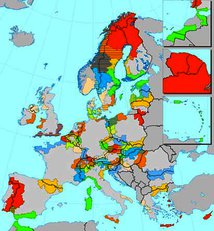Cross-border cooperation
Introduction
Cross-border programmes follow on from Interreg with its three previous programming periods: Interreg 1990-1993, Interreg II 1994-1999, Interreg III 2000-2006.
Under Objective 3 – “European territorial cooperation” – for the 2007-2013 programming period, the assistance given to cross-border cooperation is, according to the terms of the regulation on the European Regional Development Fund (ERDF), focused on the following priorities: “the development of cross-border economic, social and environmental activities through joint strategies for sustainable territorial development”.
Cross-border cooperation has seen an expansion of the geographical areas concerned by cooperation compared with Interreg III, particularly with respect to maritime cooperation as a result of the application of the 150 km rule. France, which is notably affected by this expansion in its territories bordering the English Channel and its overseas departments and territories, is concerned by 12 cross-border cooperation spaces under Objective 3.
There are 53 cross-border cooperation programmes in Europe, in addition to which there are cross-border cooperation programmes under the instrument for pre-accession assistance (IPA).
For the 2014-2020 programming period (according to the European Commission’s October 2011 proposal) “cross-border cooperation should aim to tackle common challenges identified jointly in the border regions (such as poor accessibility, inappropriate business environment, lack of networks among local and regional administrations, research and innovation and take-up of information and communication technologies, environmental pollution, risk prevention, negative attitudes towards neighbouring country citizens) and exploit the untapped potentials in the border area (development of cross-border research and innovation facilities and clusters, cross-border labour market integration, cooperation among universities or health centres), while enhancing the cooperation process for the purpose of the overall harmonious development of the Union.”


